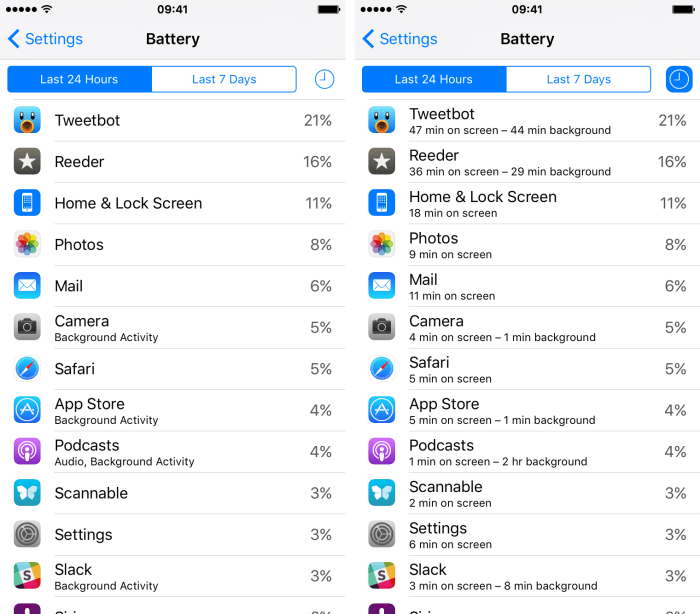Android marshmallow per app battery usage mah – Android Marshmallow: Per-App Battery Usage in mAh delves into the intricacies of battery management on Android Marshmallow, focusing on how to understand and optimize battery consumption at the app level. This comprehensive guide explores the features introduced in Marshmallow, like Doze mode and App Standby, which significantly impact battery life. We’ll uncover how to access and analyze detailed battery usage data, including mAh consumption per app, and identify factors that contribute to battery drain. Furthermore, we’ll provide practical tips and tricks for optimizing battery life, troubleshooting common issues, and utilizing battery monitoring tools.
The information presented in this guide will empower you to make informed decisions about your battery usage, extending the lifespan of your Android Marshmallow device and maximizing its performance. By understanding the nuances of battery management and utilizing the techniques Artikeld here, you can enjoy a seamless and efficient mobile experience without constantly worrying about battery life.
Understanding Android Marshmallow’s Battery Management: Android Marshmallow Per App Battery Usage Mah
Android Marshmallow brought significant improvements to battery management, focusing on extending device lifespan and enhancing user experience. Key features introduced in Marshmallow, such as Doze mode and App Standby, played a crucial role in optimizing battery consumption. These features effectively manage power usage by intelligently prioritizing apps and background processes, ultimately contributing to a longer battery life.
Doze Mode
Doze mode is a power-saving feature that activates when a device is stationary and inactive for a certain period. During Doze mode, the system restricts background activity, significantly reducing power consumption.
Doze mode intelligently analyzes the device’s state, including its position and screen status, to determine when to activate. When a device is idle and stationary, Doze mode kicks in, limiting background processes and network access. This minimizes battery drain by preventing apps from unnecessarily consuming power in the background.
Doze mode significantly reduces power consumption by limiting background activity when a device is stationary and inactive.
For example, when a phone is left untouched on a desk or in a pocket, Doze mode will activate, minimizing the impact of apps running in the background.
App Standby, Android marshmallow per app battery usage mah
App Standby is another crucial feature that optimizes battery usage by managing the activity of apps that are not actively used. The system analyzes app usage patterns and identifies those that are not frequently accessed. For apps that are not in use, App Standby restricts their background activity, limiting their access to data and resources. This minimizes the impact of inactive apps on battery consumption.
App Standby restricts background activity of inactive apps, minimizing their impact on battery consumption.
For example, if an app is rarely used, App Standby will restrict its background activity, preventing it from consuming power unnecessarily.
Accessing Battery Usage Data
Android Marshmallow provides a detailed breakdown of battery usage per app, allowing you to identify which apps are consuming the most power and make informed decisions about optimizing your device’s battery life.
To access this information, navigate to your device’s settings and locate the “Battery” section. You’ll find a comprehensive overview of your battery usage, including the overall battery level, time remaining, and the apps consuming the most power. This information is crucial for understanding your device’s power consumption patterns and making necessary adjustments to improve battery life.
Battery Usage Data Display
This section presents the information displayed when accessing battery usage data in Android Marshmallow.
The battery usage data is presented in a clear and concise manner, allowing you to quickly identify the apps that are consuming the most power. Each app is listed with its name, battery consumption in mAh (milliampere-hour), and the percentage of total battery usage it accounts for. Additionally, you can see the time spent using the app, providing further insights into its power consumption patterns.
The mAh value represents the amount of electrical charge consumed by the app, providing a direct measure of its power usage.
For instance, an app consuming 100 mAh might be considered a significant power consumer, while an app consuming only 10 mAh might be considered relatively efficient. By analyzing the mAh values of different apps, you can identify those that are draining your battery quickly and take appropriate action.
Conclusion
Understanding Android Marshmallow’s battery management system and per-app battery usage in mAh allows you to take control of your device’s power consumption. By applying the insights and strategies presented in this guide, you can effectively optimize battery life, troubleshoot common issues, and ensure a smooth and uninterrupted mobile experience. Remember, a well-managed battery translates to a more enjoyable and efficient use of your Android Marshmallow device.
Android Marshmallow’s per-app battery usage in mAh is a helpful feature for managing battery life. It can be a bit tricky to figure out which apps are draining the most power, but there are tools that can help you identify the culprits.
Sometimes, though, it’s the unexpected that catches you off guard, like when Motorola accidentally tweets about the Moto 360 motorola accidentally tweets moto 360 before its official launch. After a little investigation, you can usually pinpoint the apps using the most battery and adjust your usage accordingly, but sometimes the unexpected happens, and that’s when you need to be prepared!
 Securesion Berita Informatif Terbaru
Securesion Berita Informatif Terbaru
